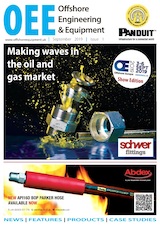Demanding environments require simple solutions
Published: 27 August, 2015
Specifying the right generator set for offshore drilling and production applications can be a complex task, with a wide range of variables to consider – from size and power output, to regulatory compliance, to implementing the right maintenance regime. In hazardous areas this becomes even more critical, with customers requiring equipment that is not only fuel efficient with a low cost of ownership but, most importantly, is inherently safe. ODEE spoke to one manufacturer about some of the key factors to consider when specifying an offshore generator set for hazardous environments.
Off-the-shelf or bespoke?
Customers typically have a choice between investing in a fully bespoke ATEX solution, purpose designed for the application, or selecting a more standard product package.
This decision will be driven by a number of factors, including the timescales available and the complexity of the engineering solution required, so it is vital to choose a supplier that can offer a full consultation and design service, to advise on the best solution available.
ODEE spoke to Finning, who explained that it offers its Cat HazPak series as a standard product package that can be ordered, built and delivered in a short timeframe. The manufacturer says this provides customers with a quick solution to custom power needs when an application takes them into hazardous areas.
As they are pre-engineered and fully ATEX certified as standard, Cat HazPak engines can be simply attached to the equipment they are powering for ease of installation, helping customers to save both time and money.
However, a standard, off-the-shelf solution isn’t always suitable, particularly for high horse power and customer applications and this is when customers need to seek a supplier that can design, build and test bespoke ATEX solutions.
Purpose-engineered for the application, these can be built to comply with a number of stringent safety and environmental demands, and particular importance should be placed on maintaining design integrity, even when alternative parts are required.
In a recent project, Finning told ODEE that an international oil and gas facilities service provider selected the company to provide a custom-engineered, hazardous area generator package to power a submersible fire pump and motor.
The Finning diesel generator set, comprising a Caterpillar 3512B marine engine and driving an alternator provides dedicated power at 6600v to a floating production, storage and offloading unit, operating offshore in Malaysia.
The generator set is deck mounted and had to comply with a number of stringent safety and environmental requirements, including DNV Marine Classification and the SOLAS safety standard. It also has to start and stop in accordance with the NFPA20, the National Fire Protection Association’s rules for fire pumps.
The customer also required a number of engineering modifications to ensure that the generator set’s cooling system was optimised for high ambient conditions and the harsh operating environment.
Finning engineered a bespoke exhaust gas cooler that limits the exhaust gas to below 200 0C and particular attention was made to ensure that there is always constant power to the cooling fans.
The air blast radiator, which cools both the engine and the gas cooler is located outside of the container and has six, EExd fans powered by a second alternator driven from the front of the engine.
Turnkey projects
Customers working in offshore environments demand equipment that can withstand harsh conditions and provide a continuous source of power. Reliability is paramount in these remote locations to ensure productivity is maintained, but so too is the need for lower cost of ownership.
This often sees customers demanding short lead times, fast delivery and a rapid installation process, to save both time and money, alongside a single source supply for warranty and service work.
Modular generator solutions can be an ideal way to address this demand for rapid turnaround, providing a generator complete with all ancillary and control equipment in a single, purpose-designed package.
These modules can be easily assembled on site at a shipyard or fabricators’ yard. Features such as the ability to install the complete generator set through the upper access hatch enables construction of the module and the generator set at the same time, helping to shorten overall delivery and the installation process
Customers will also need to consider the available fuel and commission a generator set to suit the source most readily available, whether this is liquid fuel, diesel oil, crude oil, heavy fuel oil, gas or even bi-fuel. This can help to save significantly on bought-in energy costs and reduce the expense of fuel transportation and storage.
Emergency scenarios
Careful consideration should also be made to the generator set’s ability to operate reliably in fault or emergency scenarios. For example, the engine will need to meet stringent marine classifications and offshore fire regulations, with the ability to withstand a fire for a certain duration without affecting generator performance.
Many engines are also specified to operate at a certain degree of tilt during evacuation procedures, which requires careful planning of the engine support structures and the ancillary equipment, such as the fuel tanks, radiators and bearings to ensure they can continue to perform reliably.
Maintenance regime
Operators are keen to keep existing assets running as efficiently as possible, for as long as possible. At the same time, there will be stringent regulations in place governing maintenance schedules, driven by both health and safety and rig safety case compliance. In some instances, these have been in existence for a number of years and may not be offering added value, in terms of incorporating the latest industry best practice.
Implementing a comprehensive service support package can help operators to maintain generator set reliability and optimise performance.
Suppliers should also be able to provide cost evaluations on older installations and make an assessment on whether it may be more cost effective in the long term to replace with a newer model, rather than continuing to repair reoccurring faults.
For further information please visit: www.finning.co.uk





